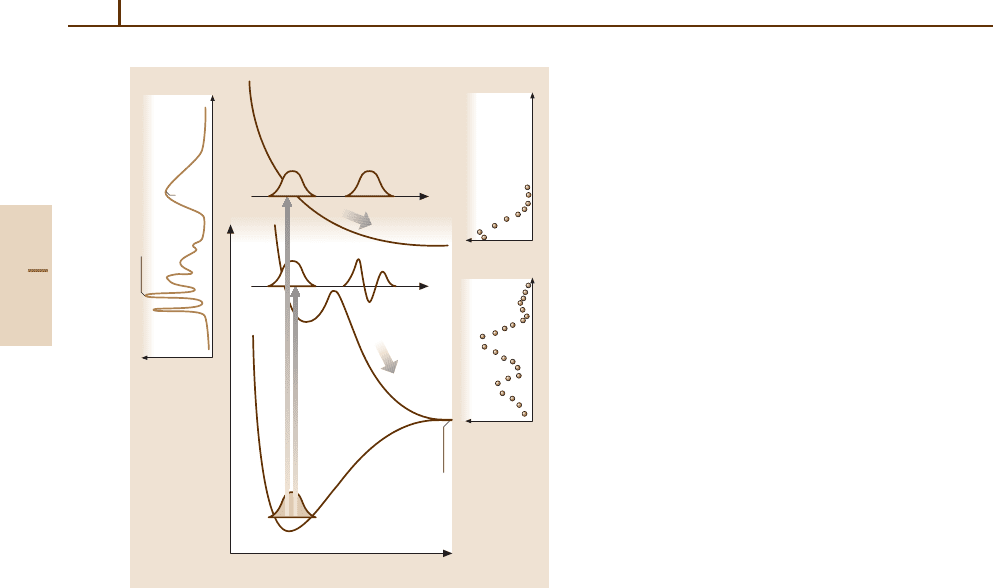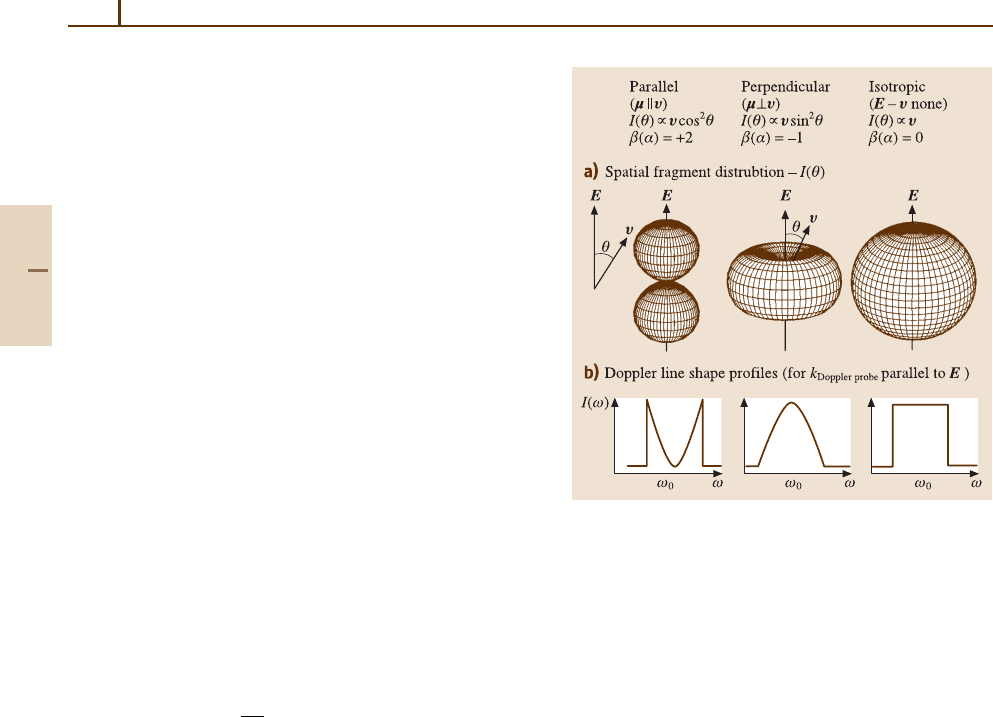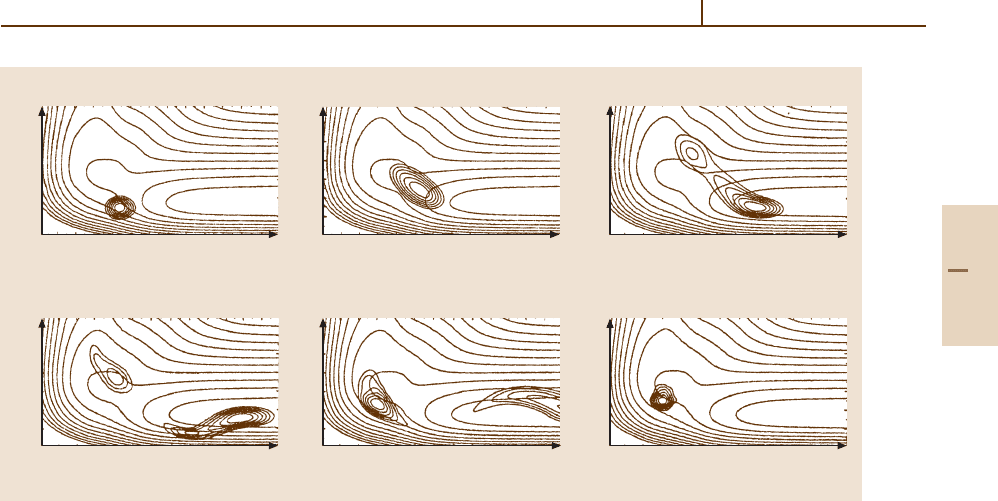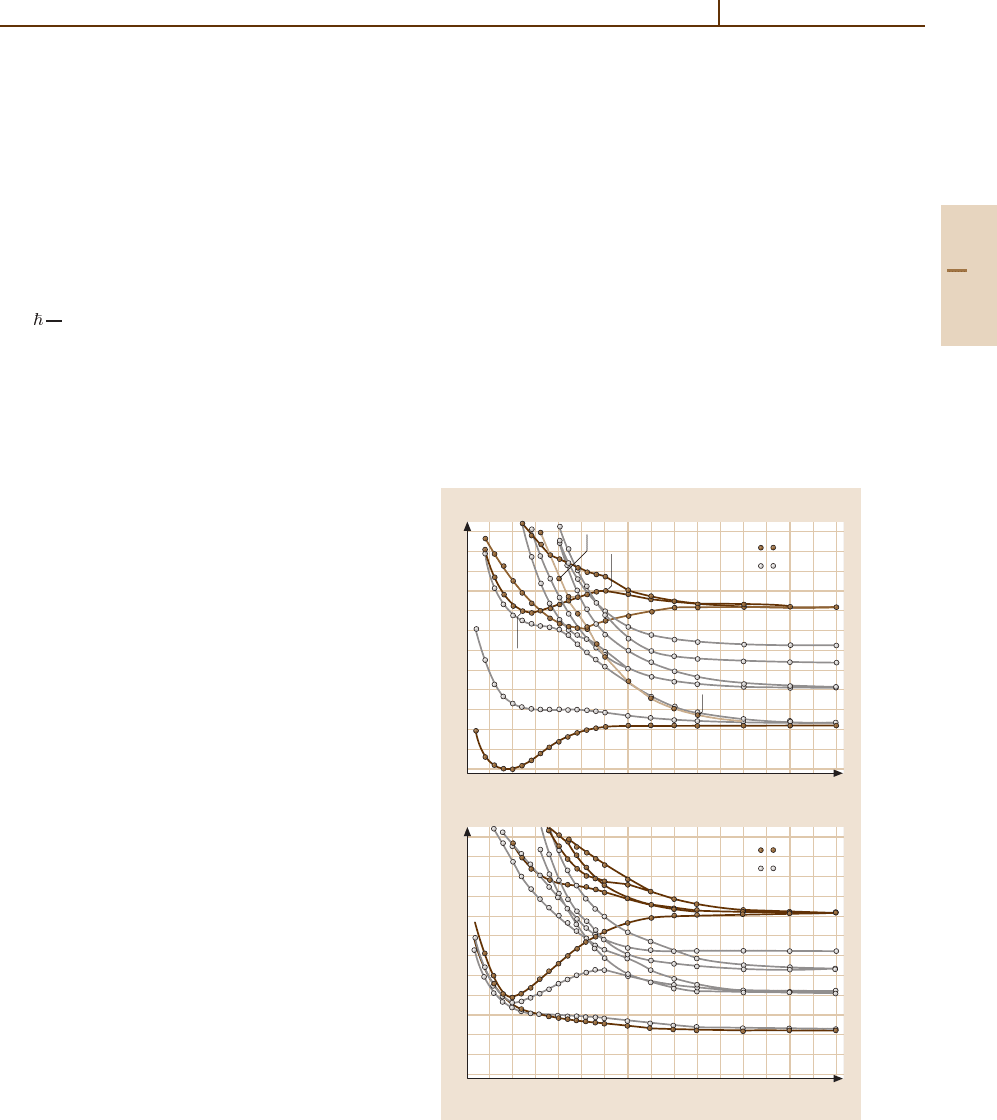Drake G.W.F. (editor) Handbook of Atomic, Molecular, and Optical Physics
Подождите немного. Документ загружается.


535
Molecular Pho
34. Molecular Photodissociation
Molecular photodissociation is the photoinitiated
fragmentation of a bound molecule [34.1]. The
purpose of this chapter is to outline the ways in
which molecular photodissociation is studied in
the gas phase [34.2]. The results are particularly
relevant to the investigation of the species involved
in combustion and atmospheric reactions [34.3].
34.1 Observables ........................................ 537
34.1.1 Scalar Properties ....................... 537
34.1.2 Vector Correlations .................... 537
34.2 Experimental Techniques ..................... 539
34.3 Theoretical Techniques ........................ 540
34.4 Concepts in Dissociation ....................... 541
34.4.1 Direct Dissociation..................... 541
34.4.2 Vibrational Predissociation ......... 542
34.4.3 Electronic Predissociation........... 542
34.5 Recent Developments........................... 543
34.6 Summary ............................................ 544
References .................................................. 545
Conceptually the photodissociation process can be di-
vided into three stages. During the first stage the
molecule absorbs a photon and is promoted to an excited
state. This is generally an excited electronic state, but can
be a highly excited vibrational state in the ground elec-
tronic state. In the second stage, the transient complex
evolves through a series of transition states, until finally,
in the third stage, the molecule enters the exit channel
and dissociates into the products. Schematically, this
might be represented, for a triatomic molecule ABC
(see Fig. 34.1), as
ABC +
ω → (ABC)
‡
→ AB(v, j ) + C . (34.1)
In the case of the triatomic molecule represented here,
the dissociation involves the transformation of one of
the vibrational modes to a translational, or dissocia-
tive, mode, another vibrational mode (the bending) to
rotational motion of the products ( j), whilst the third
vibrational mode is preserved (v).
When the molecule is promoted to an electronic state
which has a purely repulsive potential energy surface
(PES), it undergoes very rapid dissociation, often in
less than one vibrational period. This is called direct
dissociation. However, the dissociation of the transient
complex can be delayed, taking place over many vi-
brational periods. This is called indirect dissociation,or
predissociation, and has been divided into three different
categories [34.4], though as with the division between di-
rect and indirect, this is sometimes somewhat arbitrary.
Vibrational Predissociation (Herzberg Type II)
In this case, the transient complex is on a vibrationally
adiabatic potential energy surface (this is an effective
potential for the molecule when it is in a particular vi-
brational state v) which is not dissociative, or which has
a barrier to dissociation. Therefore, to dissociate it must
either tunnel through the barrier, which is the only pos-
sibility for v = 0, or undergo a nonadiabatic transition
to a lower vibrational state, thereby transferring energy
from a vibrational degree of freedom to the dissociative
mode. This process of energy exchange is commonly
called the intramolecular redistribution of vibrational
energy (IVR).
Rotational Predissociation (Herzberg Type III)
In this case, the transient complex is on a nondisso-
ciative rotationally adiabatic potential energy surface.
Therefore, in a similar manner to vibrational pre-
dissociation, if it is to dissociate it must undergo
a nonadiabatic transition to a lower rotational state,
thereby transferring energy from rotation to the disso-
ciative mode.
Electronic Predissociation (Herzberg Type I)
In this case, the PES of the electronic state of the
transient complex is not dissociative at the given en-
ergy, and in order to dissociate the molecule must
undergo a nonadiabatic transition to a second disso-
ciative electronic state. This involves the coupling of
nuclear and electronic motion and therefore leads to
Part C 34

536 Part C Molecules
α
P[AB(A,α)]
P[AB(X,α)]
α
ω
σ (ω)
ABC(B
˜
)
t⬘ =0
t⬘⬎0
ABC(A
˜
)
t =0
t ⬎ 0
ABC(X
˜
)
AB(A,α)+C
AB(X,α)+C
Dissociation coordinate R
A
˜–
X
˜
B
˜–
X
˜
V
Fig. 34.1 Schematic representation of the uv photodis-
sociation of a triatomic molecule ABC into products
AB(α) and C, illustrating the total absorption cross
section σ(ω), evolution of the molecular wavepacket,
and asymptotic product state distributions P(α), for di-
rect and indirect dissociations on
˜
B and
˜
A state PESs
respectively
a break down of the Born–Oppenheimer (BO)ap-
proximation. There are two main types of electronic
predissociation. In the first case, there is only a very
small coupling, and no actual crossing, between two
different electronic states, and the transition between
the two is driven by the very high density of vi-
brational states on the second electronic state. This
is called internal conversion for spin-allowed pro-
cesses, and intersystem crossing for spin-forbidden
processes. In the second case, the transition between
the electronic states is driven by strong coupling. This
coupling can be vibronic (vibrational-electronic) in
nature, e.g., for the Renner–Teller and Jahn–Teller ef-
fects, or purely electronic, as in the case of a conical
intersection.
Selection Rules
Two sets of selection rules apply to photodissocia-
tion. The first set governs the allowed states to which
the molecule can be promoted by the photon. These
selection rules are simply those for bound-state spec-
troscopy (Sect. 33.4). Note in particular the selection
rule ∆ J = 0, ±1. This has important practical impli-
cations since it means that a molecule which is initially
rotationally cold remains so after absorption of a photon.
Thus, those observables which are averaged over J will
have a clear structure experimentally, and will be easier
to calculate theoretically. This is in contrast to scatter-
ing experiments which in general involve a summation
over many J states (Chapt. 36).
The second set of selection rules governs the disso-
ciation process. The transient complex, or prepared ( p)
state, will undergo transitions to a final ( f ) vibrational,
rotational or electronic state in order to dissociate; these
transitions have their own set of selection rules. As for all
selection rules, these are determined on the basis of sym-
metry. For a total wave function Ψ and a perturbation
function W, which consists of the coupling terms or ne-
glected terms in the Hamiltonian,
Ψ
∗
p
WΨ
f
dτ must be
nonzero for a transition to take place. As W forms a part
of the Hamiltonian, it is totally symmetric, and there-
fore the integral is nonzero only if the prepared and final
state irreducible representations are equal, Γ
p
= Γ
f
.If
there is a transition to an excited electronic state, the
point groups of the initial and final states are often not
the same, in which case the point group formed by the
joint elements of symmetry is used, or, in the case where
there is no stable geometry for one of the states, the sym-
metry of the potential is used. For a diatomic molecule
these selection rules are given in Table 49.2.
If the motion can be separated into vibrational, ro-
tational, and electronic parts, so that Ψ = Ψ
v
Ψ
r
Ψ
e
and
W = W
v
+ W
r
+ W
e
, it is then possible to derive three
separate selection rules: Γ
r
p
= Γ
r
f
for the rotational mo-
tion, i. e. conservation of internal angular momentum;
Γ
e
p
= Γ
e
f
for the electronic motion; and Γ
v
p
= Γ
v
f
for
the vibrational motion. Since the final vibrational state
is in the continuum, in practice all vibrational species
(Γ
v
f
) are available at a given energy, so that the vi-
brational selection rule is not significantly restrictive.
This separation is not possible in the case of electronic
predissociation occurring through the Renner–Teller or
Jahn–Teller effect, where it is necessary to consider the
vibronic species of the initial and final states.
Part C 34

Molecular Photodissociation 34.1 Observables 537
34.1 Observables
Fundamental to any study of photodissociation is the
measurement or calculation of the characteristic prop-
erties, or observables, of the reaction, from which the
underlying dynamics of the fragmentation process can
be inferred.
34.1.1 Scalar Properties
The absorption cross section σ(ω) is a measure of the ca-
pacity of the molecule to absorb photons with frequency
ω. It is analogous to the line intensity in bound-state
spectroscopy. Assuming that the light-matter interac-
tion is weak (Chapt. 68), and that the light pulse is on
for a long time, the absorption cross section is given by
σ(ω) ∝ ω
fi
Ψ
f
E·
ˆ
µ
Ψ
i
2
, (34.2)
where Ψ
i
and Ψ
f
represent the initial and final states,
whose energies differ by
ω
fi
; E is a unit vector in the
direction of the polarization of the electric field, and
ˆ
µ is the electric dipole operator of the molecule. As-
suming the Born–Oppenheimer separation of electronic
and nuclear motion, (34.2) can be rewritten as
σ(ω) ∝ ω
fi
Ψ
rv
f
µ
fi
Ψ
rv
i
2
, (34.3)
where the electronic transition dipole moment µ
fi
equals Ψ
e
f
|E·
ˆ
µ|Ψ
e
i
, and is in general dependent on the
internal coordinates of the molecule. The superscripts
(r, v) will be dropped from now on, and Ψ will refer
to the wave function for the internal coordinates of the
molecule.
The absorption cross section reflects not only the
nature of the transient complex but also its evolution
through the transition states. For direct dissociation the
absorption cross section is usually very broad and struc-
tureless. In contrast, the absorption cross section for
predissociation is structured, containing lines which are
normally Lorentzian in shape, and whose widths Γ are
related to the lifetime of the transient complex at that
energy by τ =
/Γ .
The partial photodissociation cross sections σ(ω, α)
are a measure of the capacity of the molecule to ab-
sorb photons with frequency ω and to yield products in
quantum state α. They are defined by
σ(ω, α) ∝ ω
fi
Ψ
α
f
µ
fi
Ψ
i
2
, (34.4)
where Ψ
α
f
is the final wave function for the products
in the quantum state α. The partial cross sections for
direct dissociation are broad and featureless. For predis-
sociation, similar structures are seen in the partial cross
sections as in the absorption cross section. The absorp-
tion or total cross section is given by the sum of the
partial cross sections over all final product states:
σ(ω) =
α
σ(ω, α) . (34.5)
The rotational and vibrational product distributions
P(ω, α) provide information about the amount of prod-
uct formed by a photon with frequency ω in a particular
rotational or vibrational state α. These are related to the
partial cross sections by P(ω, α) = σ(ω, α)/σ(ω).The
rotational and vibrational product distributions reflect
the nature of the transient complex as it enters the exit
channel, as well as the dynamics in the exit channel.
The branching ratios for different chemical species
produced in photodissociation are defined as the fraction
of the total number of parent molecules that produce the
particular species of interest. In (34.1), the molecule
ABC dissociated into AB + C. It might equally well
have dissociated to A + BC, or indeed A + B + C. It
is clear then that there may be several different reaction
schemes, or channels, for the photodissociation of one
particular molecule. Thus, the branching ratio for form-
ing AB is the yield of this first channel divided by the
total dissociation yield into all possible channels. Fur-
ther, it would sometimes be possible to produce AB, or
any of the other chemical species, in various electronic,
vibrational or/and rotational quantum states. In this case,
the branching ratio for forming AB(α) is the yield of AB
in the specific quantum state α divided by the total yield
of AB; however, this describes the branching into only
this particular reaction channel.
For the reaction scheme represented in (34.1), the
quantum yields of the products AB and C are the same.
However, for example, in the reaction
ABC
2
+ ω → (ABC
2
)
‡
→ AB(v, j ) + 2C ,
(34.6)
the quantum yield of C is twice that for AB. In gen-
eral, the quantum yield of a particular product fragment
for one reaction channel is the ratio of the number of
fragments formed to the number of photons absorbed.
However, it is again possible for a molecule to dissociate
into various different reaction channels. In such a case,
to obtain the overall quantum yield for a particular prod-
uct, the quantum yield for each reaction channel must be
summed over all the available reaction channels, taking
into account the branching ratios for the channels.
Part C 34.1

538 Part C Molecules
34.1.2 Vector Correlations
Photodissociation is by its very nature an anisotropic
process, as can be seen from (34.2). The operator
ˆ
µ de-
fines a specific axis in the molecular body-fixed frame
of reference. At the instant of photoexcitation,
ˆ
µ is
preferentially aligned parallel to the polarization of
the electric field E in the external laboratory space-
fixed frame of reference. Hence, E defines a specific
axis, and thus cylindrical symmetry in the body-fixed
frame. If fragmentation occurs on a time scale which
is short compared with overall rotation of the excited
complex, this correlation persists between the body-
fixed frame and the space-fixed frame, and a wealth
of information can be obtained. However, rotation of
the transient complex prior to fragmentation serves
to degrade this symmetry in the external body-fixed
frame.
Three vectors fully describe the photodissociation
process for both the parent molecule and the prod-
ucts: (i)
ˆ
µ in the body-fixed frame (and hence E,in
the space-fixed frame, at the instant of photoexcita-
tion); (ii) v, the recoil velocity of the products; and
(iii) j, the rotational angular momenta of the frag-
ments. Vector correlations can exist between all of these
vectors [34.5].
The most commonly observed is the angular distri-
bution of the photofragments I(θ, α), i. e. the relation
I(θ, α) ∝
1
4π
1 + β(α) P
2
(cos θ)
(34.7)
between v and E. P
2
(x) is the second-order Legen-
dre polynomial and θ is the angle between v and E.
The anisotropy parameter β(α) ranges between −1
for a perpendicular transition and +2 for a paral-
lel transition. Thus, measuring the angular distribution
of the fragments provides information about the type
of electronic transition and hence the electronic sym-
metry of the excited state [34.6]. If the alignment
between the body-fixed and space-fixed frames is de-
stroyed, the angular distribution becomes isotropic and
β(α) = 0. The anisotropy parameter depends on the
product channel α.
A second vector correlation concerns the direc-
tion of j with respect to E. Fragmentation generates
rotational motion in the nuclear plane: for a perpen-
dicular transition this is perpendicular to the plane
containing the atoms, leading to the projection of j
being preferentially aligned parallel to
ˆ
µ, and thus
E in the space-fixed frame. For a parallel transition,
the opposite would be true, i. e. j would be aligned
Fig. 34.2 Spatial recoil anisotropies and Doppler line shape
profiles, for parallel and perpendicular transitions compared
with an isotropic distribution
in the plane perpendicular to
ˆ
µ. The alignment of
j leads to polarized emission/absorption depending
on whether molecules are created in an electroni-
cally excited/ground state. Therefore the orientation
of the product polarization with respect to the origi-
nal photolysis polarization E also yields information
about the symmetry of the electronic states involved in
dissociation.
The final association in this series is independent of
the space-fixed frame, since v and j are both defined
in the body-fixed frame. Unlike the two previous corre-
lations, a long lifetime does not destroy the alignment,
as it is not established until the bond breaks and the
two fragments recoil. For a tetratomic (or larger) mol-
ecule there are, in principle, two possible sources of
product rotational excitation: bending motion in a plane
of the molecule producing fragments with v perpen-
dicular to j; or torsional motion leading to fragment
rotation out of the plane. A prime example of this is the
distinction between frisbee and propeller type motion
of the two OH fragments in the dissociation of hydro-
gen peroxide [34.7, 8]. Measurement of only the scalar
properties cannot discriminate between these two pos-
sibilities, highlighting the additional information that
can be gained about the bond rupture and the exit
channel dynamics by the study of vector correlations
(Fig. 34.2).
Part C 34.1

Molecular Photodissociation 34.2 Experimental Techniques 539
34.2 Experimental Techniques
Early photochemical experiments used broad white-
light continuum sources and large diffractome-
ters [34.4]. However, it has been the development of
lasers in combination with molecular-beam techniques
that has dramatically increased the understanding of
photodissociation processes. The ever increasing spec-
tral and time resolutions of lasers, in addition to the
power and range of wavelengths available, have made
it possible to excite molecules selectively and with high
efficiency. This has enabled state-specific preparation of
the parent molecule, study of time evolution, as well as
the measurement of the scalar and vector properties of
the asymptotic products [34.9].
Specification of the Initial State
A room temperature sample of a gas will have a Boltz-
mann distribution over rotational states. Molecular beam
techniques provide an improved specification of the
initial angular momenta in the parent molecule by isen-
tropically cooling its internal rotational energy [34.10].
Full quantum state specification can be achieved by
various two-photon excitation schemes, e.g., stimulated
emission pump (SEP) spectroscopy and vibrationally
mediated dissociation. SEP is commonly used to study
dissociation on the ground state PES; the molecules
are excited to a stable upper electronic state, stim-
ulated emission back to the ground state prepares
a single quasibound state. Vibrationally mediated dis-
sociation provides information about both ground and
upper electronic states; the molecules are excited to
a stable intermediate vibrational level on the ground
state and further excitation promotes this fully de-
fined wave function to an upper dissociative electronic
state [34.11].
Detailed Measurement
of the Absorption Cross Section
UV and VUV electronic spectroscopy has proven a very
powerful tool for examining the interaction of a pho-
ton with a parent molecule (Chapt. 69). Absorption
cross sections are typically measured by scanning
the frequency domain and monitoring either the in-
tensity of radiation absorbed or the flux of product
molecules produced. State specific detection of the
product flux yields the partial cross section σ(ω, α).
Explicit measurement of σ(ω) is a direct applica-
tion of the Beer–Lambert law (Sect. 69.1) and thus
depends on the length of the optical cavity: cavity
ring-down spectroscopy with multiple passes through
a cell provides an effective cell length of several tens of
kilometers.
Evolution of the Transient Complex
The evolution of the molecular wavepacket can be
probed by time-resolved spectroscopy, as discussed
in Chapt. 35 and [34.12]. Real-time analysis of the mo-
lecular wavepacket provides a direct insight into the
forces acting during molecular photodissociation. This
type of time-resolved spectroscopy and the energy-
resolved spectroscopy described above are mutually
exclusive due to the time-energy uncertainty principle
(Sect. 80.3.1).
Asymptotic Properties
The vast majority of photodissociation studies determine
asymptotic properties of the dissociation process, meas-
uring either internal energy, recoil velocity, or angular
distributions of the dissociation products. The prod-
uct state distributions are usually explicitly probed by
laser-induced fluorescence (LIF), resonance-enhanced
multiphoton ionization (REMPI) spectroscopy, or co-
herent Raman scattering with the relative populations of
the products obtained via line intensities.
The distribution and anisotropy of the recoil ve-
locities are measured using Doppler spectroscopy or
time-of-flight (TOF) techniques [34.13]. Doppler spec-
troscopy uses the Doppler-broadening of lines in the
LIF or REMPI excitation spectra (Sect. 69.5); the pro-
file of the line shape also depends on the recoil
anisotropy of the probed species (Fig. 34.2). How-
ever, many important molecular fragments are not
amenable to spectroscopic detection. Thus, though
lacking the ultimate state-specificity of spectroscopy,
TOF techniques by virtue of their general appli-
cability provide an appealing alternative route to
determine the product state distributions. In TOF
techniques, the time is recorded for photofragments
to recoil a known distance from the interaction
region to a detector. Due to total energy and
momentum conservation, the translational energy dis-
tribution of a fragment state specifically detected
directly implies the internal energy distribution of
the other partner product. In less favorable cases
where this is not possible, coincidence detection
schemes are employed to define the partition be-
tween translational and internal energies. Rotation of
the detection axis with respect to the polarization
of the photolysis laser yields the recoil anisotropy.
Part C 34.2

540 Part C Molecules
Advances in spatially resolved detection schemes
are now providing an improved measure of vector
correlations.
Mass spectrometry can be used to measure branching
ratios and quantum yields, which can also be obtained
from the techniques described above.
34.3 Theoretical Techniques
The calculation of the observables of photodissociation
can be carried out using quantum mechanics either in
the time-independent or the time-dependent frame, as
well as using classical mechanics [34.1]. Theoretical
studies have contributed greatly to the understanding of
photodissociation processes, as they provide the ability
not only to calculate the observables, but also, through
the knowledge of the wave function, to view directly the
dissociation dynamics. This has enabled the inference
of the underlying dynamics from the observables of the
reaction to be more precisely established.
Due to computer limitations, the majority of quan-
tum mechanical studies currently treat fully only three
degrees of freedom, and thus have mainly concentrated
on triatomic molecules. Jacobi coordinates are usually
used, with the appropriate set for the dissociation of
ABC into AB and C as follows: R, denoting the dis-
tance between the atom C and the centre of mass of the
AB fragment; r, denoting the internal vibration coordi-
nate of AB; and γ , denoting the bending angle between
R and r.
The initial state Ψ
i
is generally taken to be a single
bound state. It is obtained either by the solution of the
Schrödinger equation at a particular energy (Sect. 31.4),
or simply by taking a product of three Gaussians in the
three coordinates, with the parameters of the Gaussians
being determined from spectroscopic information on the
ground state.
Further, to calculate the observables it is also nec-
essary to have information about µ
fi
.However,this
is often assumed to be a constant, i. e. independent of
the internal coordinates of the molecule. The Franck–
Condon principle assumes that the nuclear geometry
changes after the electronic transition, and not during
it. Therefore a molecule, with a particular geometry,
will, when promoted by the photon to the excited elec-
tronic state, be centred around the same geometry,
which is thus referred to as the Franck–Condon region,
or point.
To carry out any dynamical calculations it is nec-
essary to have PESs for the electronic states involved.
These are usually obtained from ab initio calculations
which are described in Chapt. 31. The accuracy of the
PES surface largely determines the accuracy of the re-
sults obtained, as the PES essentially determines the
dynamics of the fragmentation process.
In the time-independent approach, a solution of the
time-independent Schrödinger equation
ˆ
H− E
Ψ
α
= 0 , (34.8)
is sought for a specific total energy E subject to appro-
priate boundary conditions at infinite product separation.
There are many different approaches to solving this
problem, but they can be broadly separated into two
groups: scattering methods and L
2
methods. The scatter-
ing methods involve the solution of the coupled channel
equations described in Chapt. 36. These can be solved
directly to yield the wave functions, which can then be
used to calculate the observables, or can be solved in-
directly to provide similar information. The use of L
2
methods, which attempt to expand Ψ in a finite basis set,
is not directly applicable since the wave functions are
in the continuum and spread out to infinite distances in
the R coordinate. Thus various modifications have been
introduced in order to take this into account. The most
important of these use variational principles [34.14],
such as that due to Kohn [34.15]. In the Kohn variational
principle the wave function in the inner or interaction re-
gion is expanded in a finite L
2
basis. However, in the
outer region, the wave function is expanded in an en-
ergy dependent basis of outgoing and incoming waves,
which are approximate solutions of the coupled channel
equations. Other methods which can sometimes be used
to indirectly extract information about the observables
are stabilization [34.16] and complex scaling [34.17].
In the time-dependent approach [34.18], one solves
the time-dependent Schrödinger equation
i
∂
∂t
Φ(t) =
ˆ
HΦ(t)
(34.9)
for the wavepacket Φ(t) with initial condition
Φ(0) = Ψ
i
, i. e. it is assumed that the molecule is ver-
tically promoted by an infinitely short pulse to the
electronic state under consideration. The wavepacket
is a coherent superposition of stationary wave func-
tions Ψ
α
(Chapt. 35), and since it comprises many of
the stationary states, it contains all the information
necessary to characterize the dissociation (see Fig. 34.3).
Part C 34.3

Molecular Photodissociation 34.4 Concepts in Dissociation 541
3.0
2.6
2.2
1.8
2.5 2.9 3.3 3.7 4.1 4.5 4.9 2.5 2.9 3.3 3.7 4.1 4.5 4.9 2.5 2.9 3.3 3.7 4.1 4.5 4.9
2.5 2.9 3.3 3.7 4.1 4.5 4.9
3.0
2.6
2.2
1.8
2.5 2.9 3.3 3.7 4.1 4.5 4.9 2.5 2.9 3.3 3.7 4.1 4.5 4.9
3.0
2.6
2.2
1.8
3.0
2.6
2.2
1.8
3.0
2.6
2.2
1.8
3.0
2.6
2.2
1.8
d) e) f)
a) b) c)
r(a
0
) r(a
0
) r(a
0
)
r(a
0
) r(a
0
) r(a
0
)
R(a
0
) R(a
0
) R(a
0
)
R(a
0
) R(a
0
) R(a
0
)
Fig. 34.3 Time evolution of a wavepacket in the dissociation of FNO in the S
1
state
The total absorption cross section is given by
σ(ω) ∝
+∞
−∞
dtS(t) e
−iωt
, (34.10)
where the autocorrelation function S(t) is defined as
S(t) =Φ(0) | Φ(t) .
(34.11)
The autocorrelation function reflects the motion of the
wavepacket, and therefore is a convenient means for
visualizing the molecular dynamics. The individual par-
tial cross sections can be obtained in the limit t →∞
by projection of the wavepacket onto the stationary
wave functions of the products, i. e. plane waves in the
dissociation coordinate and vibrational-rotational wave
functions for the free products.
34.4 Concepts in Dissociation
There has been substantial experimental and theoretical
work to elucidate the processes involved in photodisso-
ciation from knowledge of the observables, and much
progress has been made. In this section, an attempt is
made to present some of the simpler ideas which have
emerged [34.1].
34.4.1 Direct Dissociation
Direct dissociation is the very fast rupture of a bond af-
ter a molecule has been promoted to an electronic state
which has a purely repulsive PES. A very clear picture
of this process can be obtained from wavepacket calcu-
lations: the wavepacket which is placed on the repulsive
surface moves directly down the PES and into the exit
channel. The autocorrelation function decays from one
to zero in a short time and does not show any recur-
rences, i. e. oscillations in the autocorrelation function.
The absorption cross section σ(ω), which is the Fourier
transform of the autocorrelation function (34.10), is
therefore a very broad Gaussian with no structure. The
breadth of σ(ω) is inversely proportional to the width of
the autocorrelation function and can, using simple clas-
sical pictures, be taken to be approximately proportional
to the steepness of the potential at the Franck–Condon
point. The partial cross sections have a similar struc-
ture to the total cross section, though they have differing
intensities and are shifted relative to each other on the
energy scale.
The product distributions can be predicted using
simple classical pictures. These methods can be di-
vided into two groups, depending on the extent of the
Part C 34.4

542 Part C Molecules
excitation/de-excitation, or coupling, in the exit chan-
nel. If there is very little excitation/de-excitation in
the exit channel, the rotational and vibrational product
distributions are best described using Franck–Condon
mapping. Another model which gives good results for
the rotational distributions is the impact parameter, or
impulsive, model. If excitation/de-excitation in the exit
channel is not negligible, the product distributions are
best described using the reflection principle.Thisre-
lates the distribution of the initial wavepacket in γ to
the final rotational distributions through the classical
excitation function. Similarly, the distribution of the
initial wavepacket in space is related to the final vibra-
tional distributions through another classical excitation
function.
Even for a purely repulsive PES, the potential may
be very flat in the Franck–Condon region so that the
molecule may be able to undergo one internal vibra-
tion before it dissociates. In this case, there is a diffuse
structure in σ(ω), associated with recurrences in the
autocorrelation function. The spacing of the structures
in σ(ω) are related to the period of the internal vibra-
tions by ∆ E = 2π
/T . Diffuse structures in σ(ω) have
also been linked to unstable periodic orbits.
34.4.2 Vibrational Predissociation
Vibrational predissociation is dissociation delayed due
to the trapping of the energy of the molecule in modes
orthogonal to the dissociation coordinate. It can be ex-
plained very clearly in the time-independent picture as
resonances (sometimes known as Feshbach resonances),
which are simply extensions of the bound states into
the continuum. σ(ω) in this case consists of a series of
Lorentzian lines, whose width is inversely proportional
to the lifetime of the resonance. In the case where the
internal modes of the molecule are not strongly coupled
to each other or to the dissociation mode, these reso-
nance states can often be assigned, with the number of
quanta in each mode being specified. In this case, the
lines in σ(ω) form a series of progressions. The widths
of these lines, and thus the lifetimes of the resonance
states, often show trends relating the lifetimes to the as-
signment. This is called mode-specificity. In the case
that the system is strongly mixed, it is not possible to
make an assignment of the resonances, and the life-
times show strong fluctuations. This is called statistical
state-specificity [34.19].
The resonances can also be seen in the time-
dependent picture, where the autocorrelation function
shows many recurrences with periods T , depending
on the fundamental frequencies of the internal modes
ω = 2π/T (Chapt. 35).
The partial cross sections for vibrational predissoci-
ation also consist of Lorentzian lines, with positions and
widths exactly as for the total cross sections, but with
differing intensities. The partial widths, which describe
the rate of dissociation into each product channel, are
given by
Γ
α
= Γ
σ(ω, α)
σ
tot
(ω)
.
(34.12)
In the weak coupling case, simple pictures can be
used to describe the product distributions. The rotational
product distributions can be explained using again the
reflection principle; but in this case, instead of consider-
ing the distribution of the initial wave function in γ ,the
distribution of the wave function at the transition state
is used. The vibrational product distributions can often
be well described by examining vibrationally adiabatic
curves.
In the case that the modes are strongly coupled, the
simple models break down. It is then sometimes pos-
sible to use statistical models to describe both the rates
and the product distributions. One example of these
unimolecular-statistical theories is the Ramsperger–
Rice–Karplus–Marcus (RRKM) theory, which is widely
used for the description of unimolecular dissocia-
tions [34.20]. Another example is phase space theory
(PST) [34.21, 22] which is often used to calculate the
product distributions for reactions which have no bar-
rier. The quantum mechanical results fluctuate about
these average values. These fluctuations, which can be
considered as being independent of the system, can be
described well by the predications of random matrix
theory [34.23].
34.4.3 Electronic Predissociation
Nonadiabatic transitions between two or more electronic
states are a common phenomenon in photodissocia-
tion [34.24] as well as in other chemical reactions
(Chapt. 49). Such transitions can result in the produc-
tion of both electronically excited and ground state
fragments.
Adiabatic molecular PESs can vary in complex fash-
ions. Many of these contortions arise from avoided
and real crossings of the surfaces, and in all such
cases, the physical and chemical understanding is
greatly facilitated by expressing the adiabats in terms
of the diabatic states (Chapt. 31).Theelectronicdi-
abatic states are chosen to simplify the structure of
Part C 34.4

Molecular Photodissociation 34.5 Recent Developments 543
the electronic wave functions by incorporating the off-
diagonal or coupling elements as a pure potential energy
term, rather than as a kinetic term, or a mixture of
both.
Under these conditions, the BO approximation is in-
adequate since there is coupling between the different
adiabatic states, and the electronic and nuclear motion
cannot be separated. Therefore the solution of the time-
dependent Schrödinger equation (Sect. 34.3) requires
the set of coupled equations
i
∂
∂t
Ψ
1
Ψ
2
=
V
11
+ T
11
V
12
V
12
V
22
+ T
22
Ψ
1
Ψ
2
,
(34.13)
to be propagated, where the coupling between the dia-
batic surfaces is in the potential (V ) and not the kinetic
(T ) terms. The wavepacket evolves on both diabatic (or
adiabatic) surfaces, and shows a complicated motion in
moving between the two surfaces. The coupling between
the nuclear and electronic motion can be thought of as
resulting in the nuclear motion forcing the transfer of
a valence electron to another molecular orbital. Since
the efficiency of this transfer is greatest when the or-
bitals are degenerate, the crossings of the wavepacket
between the PESs are generally localized around their
degeneracies. Finally, the wavepacket moves out on the
adiabatic surfaces towards the products, with which they
are correlated.
34.5 Recent Developments
In recent years, the field of photodissociation has seen
a number of intriguing applications and comparisons
between detailed experimental data and high-quality
ab initio calculations. These applications have become
feasible mainly because of the possibility to construct
accurate potential energy surfaces from first principle
electronic structure calculations. Cases in which the
fragmentation proceeds via two or several electronic
states have been especially concentrated on [34.26]. In
these cases the Born–Oppenheimer approximation is not
valid and the coupling between electronic and nuclear
degrees of freedom is essential (Sect. 34.4.3). A nice
example is the photodissociation of water in the sec-
ond absorption band. Since water has only 10 electrons,
highly accurate potential energy surfaces have been
calculated theoretically, and these have been used in
extensive dynamics calculations – including motion on
three potential energy surfaces [34.27]. The agreement
between the calculated and the measured absorption
cross section at room temperature is outstanding [34.28].
From the elaborate analysis of product state distributions
(rotational, vibrational, and electronic), many details
about the coupled motion on several potential energy
surfaces have been learned [34.29, 30]. The electronic
density of water is small, and therefore the photodisso-
ciation can be treated on a nearly exact level. For other
triatomic molecules, with more electrons and a higher
density of electronic states, this is generally not fea-
sible. An important example is ozone, which plays
a vital role in the atmosphere. The electronic structure of
O
3
is illustrated in Fig. 34.4, where many spin-allowed
as well as spin-forbidden fragmentation pathways are
6
5
4
3
2
1
0
6
5
4
3
2
1
0
Potential energy (eV)
R
1
(a
0
)
2.0 2.5 3.0 3.5 4.0 4.5 5.0 5.5 6.0
Potential energy (eV)
R
1
(a
0
)
2.0 2.5 3.0 3.5 4.0 4.5 5.0 5.5 6.0
B
R
A
B
R
1
A'
3
A'
1
A''
3
A''
A
Fig. 34.4 Electronic structure of ozone. Shown are cuts
through the potential energy surfaces for the singlet and
triplet states. After [34.25]
Part C 34.5

544 Part C Molecules
10
13
10
12
10
11
10
10
10
9
10
8
10
7
10
6
0 1000 2000 3000 4000
k(E
†
)(s
–1
)
E
†
(cm
–1
)
Fig. 34.5 Overview of the calculated dissociation rates of HOCl as
a function of the excess energy. The solid line is the prediction of
a statistical model. After [34.32]
seen [34.25]. The photodissociation of ozone in the uv
range has been the target of many experimental stud-
ies [34.31]. The interpretation of the many experimental
results on the basis of realistic potential energy surfaces
is a great challenge for theoretical chemistry.
Photodissociation studies are particularly rewarding
if the lifetime in the excited electronic state is long be-
cause then the absorption spectrum shows well resolved
lines (resonances), the widths of which are inversely re-
lated to the state-specific lifetimes [34.33]. A typical
situation is the excitation of a particular vibrational-
rotational state in a bound electronic state which can
decay only via coupling to a dissociative electronic state.
The lifetime then reflects the coupling of this state to the
continuum of the dissociative state (predissociation). An
example is the photodissociation of HCO [34.34, 35];
in this case, the upper and the lower state are coupled
by Renner–Teller coupling. A similar example is the
photodissociation of HNO. For this molecule, the lower
state has a deep potential well which supports long-lived
states in its own continuum. The mixing between the
quasi-bound states of the upper state with the resonance
states of the lower state leads to interesting behavior
in the lifetime as a function of the rotational quantum
number [34.36] (resonance between resonances).
Resonances are also prominent features of ground
state potential energy surfaces; they are the continuation
of the true bound states into the continuum (Sect. 34.4.2).
Since resonances determine the kinetics of chemical
reactions, they are usually studied in the framework
of unimolecular dissociations or unimolecular reac-
tions [34.37]. On the other hand, these resonance states
can be excited by photons, and therefore it is meaningful
to discuss them also in the context of photodissoci-
ation. In the last few years, numerical methods have
been developed to efficiently calculate the resonance
parameters [34.38–40]; see [34.37] for a comprehensive
overview. Several triatomic molecules with dramatically
different intramolecular dynamics have been investi-
gated. The main observation is a strong fluctuation in
the resonance lifetimes over several orders of magni-
tude, even for molecules whose classical dynamics is
chaotic, such as NO
2
[34.41]. Figure 34.5 shows the
results for HOCl → HO + Cl [34.32, 42]. The large
fluctuations of the lifetimes (or dissociation rates) are
believed to affect the fall-off behavior of recombination
rate coefficients [34.43].
The concept of first calculating a potential energy
surface as function of all coordinates and then perform-
ing dynamics calculations is suitable only for triatomics.
For molecules with more than four atoms it is not
applicable, simply because of the rapidly increasing
number of degrees of freedom. For larger molecules,
direct dynamics simulations, in which the methodology
of classical trajectory simulations is coupled directly
to electronic structure calculations, are the method of
choice [34.44, 45]. In these simulations, the derivatives
of the potential, which are required for the numerical
integration of the equations of motion, are obtained
directly from electronic structure theory without the
need for an analytic potential energy surface. An im-
portant application of direct dynamics is the study
of post-transition state intramolecular and unimolecu-
lar dynamics. When the dissociation proceeds through
a transition state, it may be sufficient to start trajectories
at the transition state and to follow them into the product
channels [34.46, 47]
34.6 Summary
Photodissociation of polyatomic molecules is an ideal
field for studying the details of molecular dynamics.
The primary goal of the experimental and theoreti-
cal approaches (Sects. 34.2, 34.3) is to understand
the connection between the observables (Sect. 34.1)
and the underlying chemical dynamics (Sect. 34.4).
Part C 34.6
